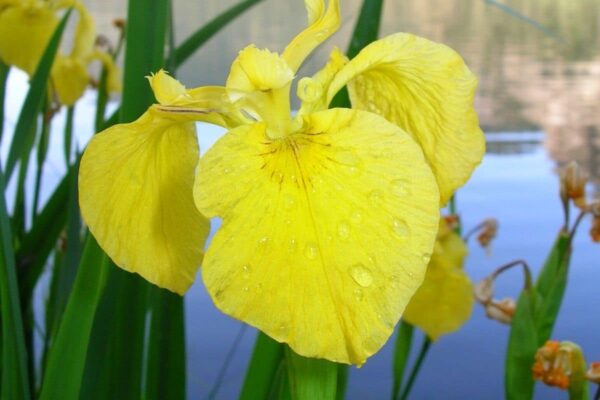Yellow flag iris
Warning
Can be toxic to humans and animals and cause human skin irritations.
About This Species
Yellow flag iris (Water flag) invades ditches, wetlands, streams, lake shorelines, and shallow ponds. It was a horticultural plant introduced from its native range of Europe, Asia, and Northern Africa. This plant reproduces through seed dispersal, horizontal roots, and when pieces of the roots break off, which can form new plants. The seeds float on the water in spring and fall, causing them to spread quickly. Several hundreds of plants may be connected underwater due to the extensive root system, which creates a thick mat that damages wildlife habitat, reduces water flow, and crowds out native vegetation. Yellow flag iris is designated as a Provincial Noxious Weed by the BC Weed Control Act, as well as a Regional Containment/Control species by the BC Provincial Priority Invasive Species List.
How to Identify
Yellow flag iris is a perennial aquatic plant that can grow to be 1-1.5 m tall on a smooth green stem.
Flowers are bright yellow, often with brown spots or purple veins, with 3 upward pointing petals and three downward pointing, tongue shaped “petals” called sepals.
Leaves are flat and sword-shaped, up to 90 cm long and 3 cm wide.
Take Action
Prevention is the best approach.
- Yellow flag iris Factsheet PDF
-
If you need advice about invasive species on your property or you are concerned about reported invasives in your local area, contact your local government or regional invasive species organization.

Clean, Drain, Dry
Learn about best practices
The Clean Drain Dry program empowers you to help reduce the spread of invasive plants and organisms to BC waters by following the clean, drain, dry procedure on all watercraft and equipment.

PlayCleanGo
Learn about best practices

Plantwise
Learn about best practices
A few non-invasive alternatives to plant instead of Yellow flag iris include:
- Bearded iris (Iris germanica)
- Blue flag iris (Iris virginica)
- Japanese water iris (Iris ensata)
- Oregon iris (Iris tenax)
- Siberian iris (Iris sibirica 'Butter and Sugar' or 'Caeser's Brother' )
REPORT TO PROTECT BC’S BIODIVERSITY

Use the app
Observe and report to protect BC’s biodiversity

Report through this website
Use our form to tell us what you’re seeing and where.


















